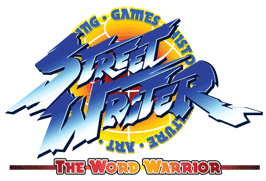If you would like to sponsor me please visit my Patreon page and consider donating each month, even as little as $1 would help make better blogs and even podcasts!
Thursday, August 13, 2020
The Street Writer Podcast, Episode 16
Konami falls apart in the arcade, and Capcom drops one of the greatest brawling games of all time in this episode.
If you would like to sponsor me please visit my Patreon page and consider donating each month, even as little as $1 would help make better blogs and even podcasts!
Friday, April 29, 2016
The Abridged History of the Brawler, part 13
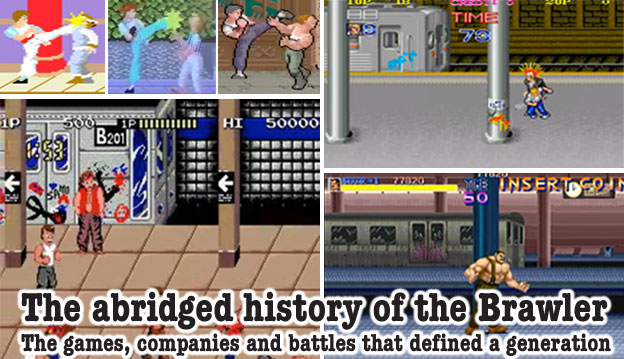
Halfway through the decade gamers would see the best that the genre had to offer. Capcom cemented their legacy with two of the best arcade titles ever released. The first one that I mention was not a brawler, Red Earth / Warzard was a fantasy-based fighting game. Unlike Konami’s Monster Maulers or Banpresto’s Metamoqester which allowed two players to combat monsters Warzard was a strictly one-on-one fighting game. It was actually the first title created to show off their new CPS-III game engine. This was something important because most in the industry and most fans had expected Capcom to show off the advanced colors, effects, animations and larger sprites that the engine could render with Street Fighter III. Capcom did release SF III on the CPS-III a few months later, but visually it was not any more impressive than Warzard.
Warzard had some RPG elements in that progress and experience made in the game could be saved on the system. In addition to leveling up armor, weapons and health bars the game also used a “magic” system that was invoked as a special attack. The four main characters, a ninja named Mukuro, an anthropomorphic lion named Leo, a witch named Tabasa and a martial artist named Tao were among the best character designs in any fighting game The redefined the archetypes from which they were based on. The villains in the game were equally amazing.
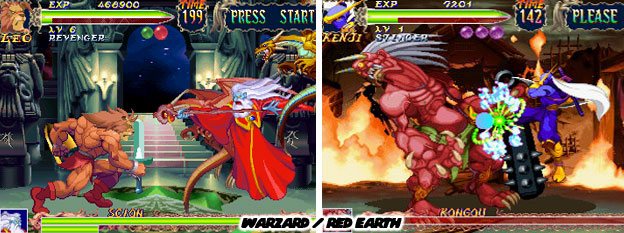
The game featured a sprite-scaling system for the sprites but when the camera zoomed in and out of the action it was not as extreme as the Sega games, the shift was slight and did not make the sprites appear flat at all. The game had a fun story and even offered multiple endings and a hint for a never to be produced sequel. It gave gamers a reason to replay the title Unfortunately the game was very rare and few arcades ever had one of their own. Of the dozens and dozens of arcades I’ve had the fortune of visiting I’ve only seen one Warzard cabinet. But I digress, I was supposed to be talking about brawling titles.
The other game Capcom released in 1996 was built on the older CPS-II engine. It was arguably the greatest brawler they ever developed and a contender for greatest brawler of all-time. Dungeons and Dragons: Shadow over Mystaria was a follow up to their previous D&D title, the Tower of Doom. It improved on the earlier title on every level.
The weapon upgrades, magic and combat systems were preserved from the previous D&D title as were the branching paths. The game was a bit longer than the original while the diversity of locations and opponents had increased. An entirely new cast of playable characters was introduced in Shadow over Mystaria including a Cleric, Dwarf, Elf and Thief. The characters had more than cosmetic differences between them, their move sets and abilities were vastly different. The Thief was a fast character that could jump off of walls and detect traps, they appeared to players as flashing signals to avoid. A group that played without a thief would end up walking blindly into traps, like having rocks drop on them from above. Just as a group that played without a Cleric would find it harder to fight undead characters or heal themselves without the aid of magic potions.

Shadow over Mystaria demonstrated how if the brawler were designed properly then it could be the perfect action-RPG. Players had real-time fights, real-time inventory management and reason to work as a team in order to survive in a fantastic but dangerous world. The artistic stylizations that sprites provided added an additional layer of appeal to the game. No 3D MMO, with its point-and-click mechanics and canned animations could ever hope to match the actual interactivity and gameplay that the brawler provided. Yet Shadow over Mystaria had a rival that year, a game that some would argue as being an even better experience and for many the greatest brawler ever released.
Treasure had a short but memorable list of games at that point in the market. The independent studio was known for their original ideas and amazing animation. Guardian Heroes was their entry into the fantasy brawling genre. The game was released on the Sega Saturn and took advantage of the 32-bit processor and increased storage capacity that CD media had over the 16-bit cartridges. Actually Treasure had pushed the hardware past its breaking point, as the game often allowed so many characters on screen and effects to be happening at once that the Saturn would slow down in the middle of the most frenetic battles. Despite the slow-down issues the game was so well designed and executed that it caught players and reviewers completely by surprise.
Players could choose from one of five character types, a warrior named Samuel, a female knight named Serena, Genji the ninja, a magician named Randy and a cleric named Nicole. Each of course with their own strengths, attacks, magic and weaknesses. Players learned what character combinations worked best for them and their style of gameplay. The game, like the best brawlers worked best with multiple players. Treasure found a way to give single players that experience by providing them with a computer controlled Undead Warrior. This character could be set to attack, defend or even go berserk by players. Being able to know when to trigger the teammate abilities was crucial to beating some of the harder bosses. The game actually began right in the middle of the action where soldiers from the kingdom were trying to recover a magical sword that Samuel had gotten. Players had to quickly learn the control and magic system while a tavern they were staying in was burning to the ground. The pacing between story and action moments was well put together.
The gameplay took place on a 2-dimensional plane rather than on an open field as in most brawlers. The reason for this was understandable. Characters could perform complex combo attacks on opponents, similar to fighting games, which required advanced commands. In a typical brawler if a player did not properly line up an attack after entering the command then it was a wasted strike. Keeping opponents on the same plane eliminated those missed opportunities. However that also meant that wave of opponents would also be able to approach from the front and back on the same plane. To give players some freedom, Treasure made it so they could jump up to two levels into the background to fight or escape opponents. It could also be done to spread out the sometimes chaotic action. No other brawler had ever offered this gameplay mechanic before. But to be fair the fighting game Fatal Fury had featured a similar mechanic years earlier.
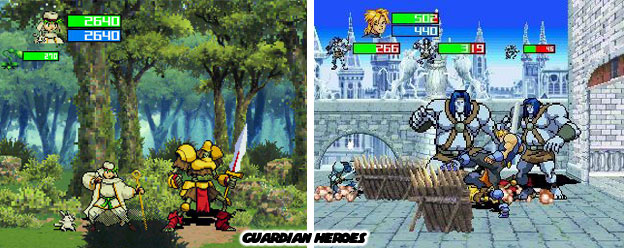
Guardian Heroes game offered many paths to follow. It was possible for gamers to have dozens of different experiences each time they played. Players could even spend points that they had earned by defeating opponents to increase their stats and abilities. Players learned to carefully balance their physical and magical attacks and take advantage of the environment and opponents. If multiple characters were near each other then players could perform a single lightning, ice or fire attack and let that attack travel like a shockwave through all of the careless enemies. Players could rack up scores of experience in the process and extend their magical attacks. Players could even take advantage of careless enemy sorcerers. If an opponent activated a healing disk for enemies to stand on and replenish their health then players could knock opponents off of that disk and give themselves the energy instead. In other videogames enemy magic seemed to only help enemies. In this game it applied to either side
The best part of the game was that every defeated opponent, from muscle bound thieves, to demons, giant robots, sorcerers, plant monsters and boss characters could be played as in a bonus fighting game. It was more like a battle royal as up to six characters could take the field at once. Some of the characters were difficult to unlock because they often did not stick around long enough to be beaten before a cut-scene loaded. Players learned to work together and take out characters as fast as they could so they could play as them in the bonus game. To say that my brothers and I played a hundred hours or more securing the characters in the Saturn’s internal memory was an understatement. Guardian Heroes was the brawling experience we had all been waiting for only we did not know it.
Treasure appeared to come out of nowhere and set the standard for animation, character and level design, control, story and even music for every console brawler yet to come. What many players did not realize was that Treasure had built Guardian Heroes on the legacy of their team. The studio was composed of former Konami employees, then known as “Star Team” for their ability to crank out hit after hit. People that had worked on their best arcade brawlers including Aliens, the Teenage Mutant Ninja Turtles, Vendetta and the Simpsons had finally returned. When they were not bound by a license and allowed to develop an original brawler then they absolutely flourished. Not simply one of the greatest brawlers ever made but one of the greatest videogames ever made. Unfortunately many players did not get a chance to experience the title when it first came out. Because it was on the Saturn console rather than in the arcade meant that it would not get the exposure that it deserved. Thankfully Xbox Live would be available some 15-years later to give a whole new generation a chance to experience it. However for fans of the arcade brawler the genre seemed to have peaked in 1996. The industry went from a few great titles every year to a few years between great titles. Find out about 1997 and Capcom’s last sprite-based arcade brawler in the next blog. As always if you enjoyed this blog and would like to sponsor me please visit my Patreon page and consider donating each month, even as little as $1 would help make better blogs and even podcasts!
Monday, April 25, 2016
The Abridged History of the Brawler, part 11

The year 1993 saw an increase in the number of brawlers released. Konami was in fine form as they continued to innovate and redefine what the genre meant. Monster Maulers was one of the first experiments between the brawler and the fighting game. The mechanics of the game were very much based on the traditional fighting game. The gameplay took plane on a 2D plane. Characters could not move into the foreground or background. Players could perform special moves on top of regular punch, kick and grapple attacks.
The only thing that made this game a brawler instead of a fighting game was in that up to two players could battle against the collection of monsters, aliens and mythological creatures on each stage. The designs were uniquely Japanese but nothing extraordinary.
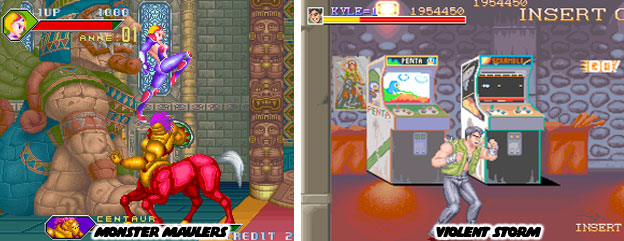
Konami the turned around and released Violent Storm. It was one of the most random, poorly designed and executed brawlers they had ever released. It was hard to believe that the same people that had released the X-Men, Ninja Turtles and the Simpsons had developed this game. It was as formulaic as brawlers got with absolutely no redeeming factors.
The sprites were large, the animation rushed, the levels sparse, the opponents bland and the bosses insipid. Konami was going through the motions and releasing brawlers just because they could. The company that could previously do no wrong had a half-hearted effort wasted on arcade owners. Their hubris would cost them market share.
Even though they pioneered a lot of fight mechanics in 2D games and were responsible for inspiring the genre through Karate Champ, Data East did not have a strong history with brawlers, especially following after Captain America and the Avengers. Night Slashers made up for that. It was a dramatic, gross and violent brawler as ever there was one. It was exactly the type of game the genre lacked.
The designs were a bit over-the-top, with a suit-wearing British vampire hunter teaming up with an American rockstar-looking monster hunter with cybernetic arms and a Chinese martial artist. The premise was dramatic gold. Monsters, mutants and the undead had taken over the world, it was up to a trio of fighters to make things right. The characters had specials and super attacks at their disposal as they took on waves of zombies and other undead creatures. The gore, like the violence featured in brawlers was catering to the tastes of guy gamers.

What really set this game above the crop of brawlers were the bonus games. Players took turns playing things like zombie bowling, in which players threw zombies from 10 yards out and zombie whack-a-mole where players kicked the heads off of zombies as they popped up from holes in the sand. It was an absurd premise as audiences gathered around these zombie events, standing behind barricades emblazoned with sponsor logos like Zombie Burger and Drug Zombies. That dark humor was what Konami was missed in Violent Storm. Sadly of all the arcades I visited I only saw one dedicated cabinet. With the popularity of zombies then perhaps we might see this Data East gem come out on PSN or Xbox Live.
Capcom did not wait to see what Konami was up to next. They secured the rights to another Marvel character and released the violent Punisher title. The game was still a co-op brawler with Nick Fury filling in for player-2. Classic villains like the Kingpin were placed alongside modern villains including Jigsaw and Bushwacker.
The game retained the Capcom Japanese aesthetic rather than strict US comic book designs. The studio did, as they always had, place exaggerated muscles on their figures so they would appeal to western gamers. Other developers were often unsure of those proportions so they always went lean with their characters. The subject matter was a little more intense in order to reflect the Punisher comic books. The Punisher comics were often more mature and brutal than other superhero books. They predated the anti-heroes from the Wanted and Kick Ass graphic novels. The game itself was violent for brawler standards, when the Punisher pulled the trigger on his guns opponents went down hard.

Capcom kept the intensity up with their next comic-to-brawler. Cadillacs and Dinosaurs was an indy comic series with a small but dedicated following. The game was based more on the work from the short-lived animated series than from the comics.
The title featured the same impacting gun play from the Punisher with the great designs from the comics and animation. The best Capcom title of the year, and for that matter the best brawler of the year, was based on a license. It was neither the Punisher or Cadillacs and Dinosaurs but instead something that was previously considered the nerdiest of pursuits.
Dungeons and Dragons: Tower of Doom was based on the fantasy roleplaying system and brought over a lot of their mythology and design into the brawler. The older Capcom fantasy brawlers, including King of Dragons and Knights of the Round, seemed to have been building towards the D&D license. The oldest of the fantasy brawlers, Magic Sword was set in a castle tower as well, some 50-stories tall. It was a brutal but rewarding quarter grabber, the levels were filled with traps and monsters, it predated the Tower of Doom by years. The game did have plenty of different character classes and even a rich narrative, still it felt as if something were missing. The D&D license allowed Capcom to bring everything together.
The Tower of Doom featured a small group of character classes that player could build through collecting coins, equipment and potions from defeated opponents. Players could visit nearby towns and upgrade their equipment and restore health with recovered loot. Instead of starting with nothing on each play through the cabinet allowed players to save their progress locally.

The attention to detail, character designs, art and animation were superb to every other title released that year or any year before. The brawler with role-playing elements was a long time coming. Capcom waited to apply it into a genre that they had become exceptional at. They knew the ins and outs of the brawler, including the nuances of timing, the difficulty curve, problems with repetition and boss encounters. While the D&D subject matter was not appealing to all of the gamers, the lessons learned from its design were invaluable.
By comparison Konami was now going through the motions with each arcade release and losing more steam by the moment. It stood to reason why their best developers were starting to leave the studio and move into console development. Their last brawler of 1993 was Metamorphic Force. The game attempted to marry the fantasy elements of warriors set in a world of shape-shifting monsters. Any of the 4-players could transform into a were-animal, including were-tiger and were-bear. Unlike the clock on Sengoku the transformations here were not timed.
The concept was great. It was as if there was a brawling version of Sega's Altered Beast. It was the execution that was lacking. The quality of the designs, brightly colored levels and sparse gameplay elements felt unpolished. This title felt more lacking than even Violent Storm. It was not however the worst brawler released that year.

Atari had become aware of the popularity of the brawler. They had been losing a market share in arcades since the late 80’s to the Japanese. To try and turn things around they published their own brawler developed by a company called Toaplan. Knuckle Bash was unique in concept, introduced some new elements but ultimately had an abysmal execution.
The game was an attempt at making a narrative out wrestlers and the wrestling business. The story revolved around crooked wrestlers and crime lords tarnishing the good name of pro wrestling. The game began with one of three characters, a masked luchador, an Elvis-gimmick wrestler and a straight-shooting wrestler. Three more characters, which were at some point in the game were bosses, could be added to the lineup. The game allowed players to switch characters between levels. Adding bosses as playable characters and allowing the switch of characters between stages was a fantastic idea. Unfortunately the game was formulaic, nonsensical and had poorly designed characters and bosses. Despite the good ideas it was one of the worst brawlers ever released. 1993 was an interesting year but the brawler was steadily declining in popularity, less and less memorable titles would be released over the rest of the decade. Some of the best experiences were still to come. As always if you enjoyed this blog and would like to sponsor me please visit my Patreon page and consider donating each month, even as little as $1 would help make better blogs and even podcasts!
Even though they pioneered a lot of fight mechanics in 2D games and were responsible for inspiring the genre through Karate Champ, Data East did not have a strong history with brawlers, especially following after Captain America and the Avengers. Night Slashers made up for that. It was a dramatic, gross and violent brawler as ever there was one. It was exactly the type of game the genre lacked.
The designs were a bit over-the-top, with a suit-wearing British vampire hunter teaming up with an American rockstar-looking monster hunter with cybernetic arms and a Chinese martial artist. The premise was dramatic gold. Monsters, mutants and the undead had taken over the world, it was up to a trio of fighters to make things right. The characters had specials and super attacks at their disposal as they took on waves of zombies and other undead creatures. The gore, like the violence featured in brawlers was catering to the tastes of guy gamers.

What really set this game above the crop of brawlers were the bonus games. Players took turns playing things like zombie bowling, in which players threw zombies from 10 yards out and zombie whack-a-mole where players kicked the heads off of zombies as they popped up from holes in the sand. It was an absurd premise as audiences gathered around these zombie events, standing behind barricades emblazoned with sponsor logos like Zombie Burger and Drug Zombies. That dark humor was what Konami was missed in Violent Storm. Sadly of all the arcades I visited I only saw one dedicated cabinet. With the popularity of zombies then perhaps we might see this Data East gem come out on PSN or Xbox Live.
Capcom did not wait to see what Konami was up to next. They secured the rights to another Marvel character and released the violent Punisher title. The game was still a co-op brawler with Nick Fury filling in for player-2. Classic villains like the Kingpin were placed alongside modern villains including Jigsaw and Bushwacker.
The game retained the Capcom Japanese aesthetic rather than strict US comic book designs. The studio did, as they always had, place exaggerated muscles on their figures so they would appeal to western gamers. Other developers were often unsure of those proportions so they always went lean with their characters. The subject matter was a little more intense in order to reflect the Punisher comic books. The Punisher comics were often more mature and brutal than other superhero books. They predated the anti-heroes from the Wanted and Kick Ass graphic novels. The game itself was violent for brawler standards, when the Punisher pulled the trigger on his guns opponents went down hard.

Capcom kept the intensity up with their next comic-to-brawler. Cadillacs and Dinosaurs was an indy comic series with a small but dedicated following. The game was based more on the work from the short-lived animated series than from the comics.
The title featured the same impacting gun play from the Punisher with the great designs from the comics and animation. The best Capcom title of the year, and for that matter the best brawler of the year, was based on a license. It was neither the Punisher or Cadillacs and Dinosaurs but instead something that was previously considered the nerdiest of pursuits.
Dungeons and Dragons: Tower of Doom was based on the fantasy roleplaying system and brought over a lot of their mythology and design into the brawler. The older Capcom fantasy brawlers, including King of Dragons and Knights of the Round, seemed to have been building towards the D&D license. The oldest of the fantasy brawlers, Magic Sword was set in a castle tower as well, some 50-stories tall. It was a brutal but rewarding quarter grabber, the levels were filled with traps and monsters, it predated the Tower of Doom by years. The game did have plenty of different character classes and even a rich narrative, still it felt as if something were missing. The D&D license allowed Capcom to bring everything together.
The Tower of Doom featured a small group of character classes that player could build through collecting coins, equipment and potions from defeated opponents. Players could visit nearby towns and upgrade their equipment and restore health with recovered loot. Instead of starting with nothing on each play through the cabinet allowed players to save their progress locally.

The attention to detail, character designs, art and animation were superb to every other title released that year or any year before. The brawler with role-playing elements was a long time coming. Capcom waited to apply it into a genre that they had become exceptional at. They knew the ins and outs of the brawler, including the nuances of timing, the difficulty curve, problems with repetition and boss encounters. While the D&D subject matter was not appealing to all of the gamers, the lessons learned from its design were invaluable.
By comparison Konami was now going through the motions with each arcade release and losing more steam by the moment. It stood to reason why their best developers were starting to leave the studio and move into console development. Their last brawler of 1993 was Metamorphic Force. The game attempted to marry the fantasy elements of warriors set in a world of shape-shifting monsters. Any of the 4-players could transform into a were-animal, including were-tiger and were-bear. Unlike the clock on Sengoku the transformations here were not timed.
The concept was great. It was as if there was a brawling version of Sega's Altered Beast. It was the execution that was lacking. The quality of the designs, brightly colored levels and sparse gameplay elements felt unpolished. This title felt more lacking than even Violent Storm. It was not however the worst brawler released that year.

Atari had become aware of the popularity of the brawler. They had been losing a market share in arcades since the late 80’s to the Japanese. To try and turn things around they published their own brawler developed by a company called Toaplan. Knuckle Bash was unique in concept, introduced some new elements but ultimately had an abysmal execution.
The game was an attempt at making a narrative out wrestlers and the wrestling business. The story revolved around crooked wrestlers and crime lords tarnishing the good name of pro wrestling. The game began with one of three characters, a masked luchador, an Elvis-gimmick wrestler and a straight-shooting wrestler. Three more characters, which were at some point in the game were bosses, could be added to the lineup. The game allowed players to switch characters between levels. Adding bosses as playable characters and allowing the switch of characters between stages was a fantastic idea. Unfortunately the game was formulaic, nonsensical and had poorly designed characters and bosses. Despite the good ideas it was one of the worst brawlers ever released. 1993 was an interesting year but the brawler was steadily declining in popularity, less and less memorable titles would be released over the rest of the decade. Some of the best experiences were still to come. As always if you enjoyed this blog and would like to sponsor me please visit my Patreon page and consider donating each month, even as little as $1 would help make better blogs and even podcasts!
Subscribe to:
Posts (Atom)
